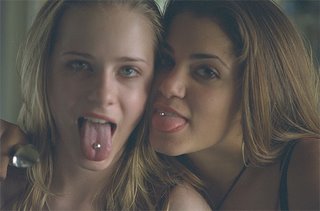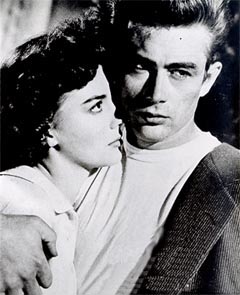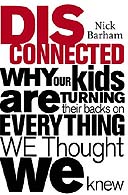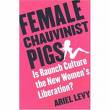Alliaya Khan
‘So I told him, brush your teeth after you lick me out.' -Becky
How is youth represented, especially females within contemporary media? - With specific reference to Kidulthood.
The hard-hitting ABSO introduced by the Police Reform Act in 2002, and sentimental 'Hug A Hoodie Scheme' proposed by the conservative leader David Cameron in 2006, represent just two of the laws enforced by the government, as an attempt to tame the reckless behaviour of youths. Our contemporary society has recently been overcome by the moral panic[1] of the teen, which as a result, has forced the government to address unresolved pending issues like sex, violence, and truancy. Headlines such as ‘Britain a nation of yobs[2]’ and ‘we’re all going to the dogs[3]’ therefore dominates the tabloids, and depicts the scandalous actions of the young; as recent statistics have exposed that a shocking 13/1000[4] marriages end in divorce and Britain’s youngest mum is aged just 11[5]. This new worrying era we now face, therefore appears to promise youths a combination of dead romance, casual sex, and boredom. The 2006 teen drama ‘Kidulthood’ depicts this approaching era, and reflects the social change evident between both genders through the key character Becky. A change in which past traditional stereotypes of the female are broken and the image of the ‘ladettete’ stands firm.
The 60’s arguably marked the beginning of this major change within society, as females and males alike conformed to the representation of the ‘hippy’. The hippy focused upon the movements of peace, love, and sexual liberation, and generally condemned both war and violence. However, it was perhaps the even earlier 1950s era of rock ‘n’ roll, that first marked a social change in the behaviour of young females; as women began to conform to the representation of the ’groupie’. The groupie glorified open promiscuity and disregarded the importance of sex, as females curiously began to explore their sexual freedom and power. Cameron Crowe’s 2000 movie ‘Almost famous’ depicts the fun loving, limitless attitude of the ‘groupie’ female, and reflects women’s changing views towards significant issues, like love and commitment. ‘Never take it seriously, if ya never take it seriously, ya never get hurt, ya never get hurt, ya always have fun.’[6] This depiction of the female, free from the chains of her past, passive stereotype, also contributed to their later representation as the ‘gold-digger’: untrustworthy, cheap, and callous, valuing the means of money, over genuine affection. The 2001 hit ‘Heartbreakers’, featuring Jennifer Love-Hewitt, reflects these contemporary female intentions, and morals, whereby girls are referred to as ‘gold diggin’ whores’, and adopt the same slapdash sexual intentions as men ‘If I were a guy, I’d do you’[7].
‘Kidulthood’s’ key character Becky however, constructs and represents a horrifying new portrayal of women in which neither class nor intelligence is employed by the female in order to effectively manipulate the male gender. Females instead are liberated through the shocking sexual advances and undignified actions of Becky, who performs oral sex in exchange for both cocaine, money, and clothing. The ‘vamps’[8], Becky and Alissa therefore represent 'danger, sexuality and the possibility of independence[9]', as they cunningly seduce the males and use them as tools to succeed. They believe they are superior to the male gender, as they ‘prostitute’ themselves, benefiting both financially and sexually. However the male merely sacrifices money in exchange for the ’precious’ act of sex. This causes the audience to perceive females as the weaker, dominated sex, as men are portrayed as controlling women through money. Becky therefore represents the more contemporary perception of the female as ‘the whore’: dirty, rebellious, and in possession of numerous sexual partners, with little regard to either preference or standard.
This representation of female youths arguably however, highlights further the female oppression evident within society, as ‘Becky’ is ‘punished‘ for enjoying carefree, casual sex. The ‘whore’ therefore reflects a contemporary era of sexual liberation and equality, as passive stereotypes are broken with active sexual advances. This is shown through HBO’s ‘Sex In The City’, which reflects the promiscuous modern day behaviour of the female and thus demonstrates the acceptance of ‘the whore’. Carrie however is perceived not as a whore, but ‘superwoman’[10](Van Zoonan): intellectual, sexy, and ambitious, as she juggles both her demanding career with an active sex life. Yet although Carrie displays the same ‘whorish’ sexual advances as ’Kidulthood’s’, ’Becky’, ‘I will wear whatever and blow whomever I want as long as I can breathe and kneel.’[11], her behaviour is instead accepted within society due to her age, air of maturity, and intellect. This therefore reflects societies prejudice towards the teen, as promiscuous grown women like Carrie are admired for their sexual activeness, however teenagers such as Becky are slandered.
Stan Cohen was the first theorist to address this prejudice towards the teen, his study of the Mods and Rockers in the 1960’s, led to the infamous ‘Folk Devils and Morale Panic’ theory. Cohen believed that young teens were presented in an unfair, negative way, and he perceived this societal indifference towards the teen and the government’s failure at controlling them, as "a condition, episode, person or group of persons [who] become defined as a threat to societal values and interests."[12] The contemporary ’hoody’, appears to be the most recent image to have established this fear within society, as authority figures, such as the Deputy Prime Minister John Prescott, refer to the ‘hoody’ as the ‘"uniform" of lawless teenagers‘[13].This is made evident within ’Kidulthood’ through the male characters Jay, Moony, and Trevor, as they are falsely accused of stealing from Burberry and are continuously watched whilst shopping. All three characters conform to the stereotypical image of the rebel ‘hoody’ and are therefore suspected by society, as thieving, dishonest and troublesome; and with 1/5[14] youths accounting for 750 000[15] shoplifting crimes within the UK, is this disapproval of the ‘hoody’ infact just, or an unfair representation of youths?
An era of cultural feminism is therefore portrayed within ‘Kidulthood‘, as contemporary teenage females now also conform to the same stereotypical image of the hooded male. Females now employ and adopt not only the same attitude and violent mannerisms as men, but also the same appearance, and language. This is reflected through the opening fight scene, which takes place between a gang of female bullies and their suicidal victim Katie. The first bouts of violence are exchanged between women and reflect the changing gender roles of society, as the past stereotype of the ’Madonna’[16]; pure, maternal, chaste, and modest, is challenged by the ’future girl’[17]; ’who is ’desirable, determined and confident.’[18]. Debbie, Becky, Claire, Alissa and Katie act as reflections of this ‘future’ female, yet none of the girls reflect these admirable qualities. Instead, Debby both bullies and dominates to feel powerful, Claire remains within an abusive relationship to feel secure, Becky pursues consistent sex in order to feel wanted, and finally Katie takes her own life to escape the abuse of her bullies. Only the pregnant female Allisa, who conforms to both the ’Madonna’, as well as the ’future girl’, is admired, as she remains strong and is guided throughout by her maternal instincts.
Furthermore whilst the majority of girls are presented within ’Kidulthood’, as ’ladettes’; boisterous, assertive and crude; the macho, polygamous stereotype of the traditional male is subverted. Jeffords states that males are instead presented within contemporary film as ‘self-effacing men, who now, instead of learning to fight, learn to love.’[19] This is reflected through the bully Sam, as he forgives his unfaithful partner Claire, the character Trevor, as he confesses his love for his pregnant girlfriend Alissa; as well as through Jay, as he demonstrates his loyalty towards his girlfriend and rejects the offer of offhand casual sex. David Guantlett’s ‘Media, Gender and identity’ argues that this change in the behaviour of both genders is a due to the flourishing career of women. He believes that the males has instead been left sensitive and unaware of their roles within society, as the majority of ’wives now bring home the bread’[20], whilst husbands have been left ’to cook in the kitchen.’[21] This further raises questions as to whether we are still living within the hegemonic patriarchy of a ‘man’s world’[22] and forces us to consider whether feminism has in actual fact ‘taken over.’
However the role of the woman, unlike men is clearly outlined within society through Sue Thornam’s ’Feminist film theory’[23] as she subcategorises the female into three significant representations, ‘ the cinematic representation, the figure of the real life woman, and the figure of the feminist theorist.’[24] Women are therefore distinguished between their roles within the home, within film, and as a provider. Haskell and Rosen focus on the women as ’a cinematic representation’ and argue ‘that film mirrors how society treats women, and that these depictions are distortions of how women ‘really are’ and what they ‘really want.’[25] This statement therefore disregards the idealistic criticism that brands ‘Kidulthood’, as both ’ Ugly and unrealistic’[26]; as the film, according to the ’reflection theory’[27]is inspired by the influences of surrounding society and it’s youth culture. Therefore characters like Becky, act as shocking reflections of the truth and represent instead the zeitgeist of the ’ipod generation’[28]; ’insecure, pressurised, overtaxed and debt-ridden.’[29]
Majorie Rosen’s ‘Popcorn Venus’[30] however, suggests that Menhaj Huda’s representation of women within ‘Kidulthood’ is a infact a misrepresentation, as she perceives movies as ‘a form of popular culture’, used simply to ‘alter the way women look at the world’ and instead ‘reflect how men intend to keep it.’[31] A patriarchal society is therefore reinforced within Kidulthood, as Huda ‘constructs the image of the woman within film by men, for a male spectator[32]’. He appears to represents females in a negative way only, punishing them for their sexual lust and vigour. This is reflected through the unresolved tragic narrative of the text, as the plot of ’Kidulthood’, according to Todorov, fails to reach a satisfying ‘equilibrium’[33]. Instead, Claire returns back to her abusive boyfriend who regards her as a ’shit fuck’, Alissa’s left devastated at the death of her unborn child’s father, whilst Becky is left drunk and alone.
The female strength of the characters Becky, Claire, and Alissa are therefore challenged within ‘Kidulthood’, as the ambiguous open narrative of the text, leaves it unclear as to whether they overcome their misfortunes and live up to the expectation of the strong, ruthless ’ladette’. The ‘ladette’ represents ‘what we are, what we were, and what we could, should, or do not want to be.‘[34] Menhaj Huda however, portrays this contemporary stereotype of the female as a representation we do not wish to conform to. He demonstrates the image of the ‘ladette’ through the character Debby, whom is fairly tall, large, and unattractive and breaks the stereotypical boundaries of passive female anger, with a mixture of right hooks, punches and uppercuts. This female aggression therefore reflects female bitching and backstabbing as trademarks of the past, with girls in favour now, of a more physical approach. Mark Water’s ’Mean Girls’ released in 2004, reflects the previous stereotype of the typical woman as the bitching ‘femme fatal’; alluring, seductive, charming and deceitful. The main characters ‘Cady Heron’, and ’Regina George’, aka ’the plastics’ employ the use of their villainous characteristics and ’feminine Wiles’[35], in order to both bully and demoralise their victims; unlike the ’ladette’ who simply attacks.
Laura Mulvey specifically refers to the use of these ‘feminine wiles’ of ’beauty, charm, and sexual skill’[36] as tools used merely to conform to the voyeuristic pleasures of men and thus reinforce the foundations of a patriarchal society. Mulvey argues within her 1975 ‘Visual pleasures and narrative cinema’ paper, that women are merely used as objects of the ‘male gaze’ within film; and like Freuds own theory of Scopophilia are perceived as ‘objects to be looked at rather than subjects with their own voice and subjectivity.’[37] Females are therefore forced to ‘transexually identify[38]’ as men, as they possess the more active, dominant, exciting roles onscreen. However still, Mulvey argues that the woman ‘remains restless in her transvestite clothes’[39], bored of her own representation as a inactive, helpless character and instead in search of a more compelling image.
This new exciting representation of the female teen was first made evident within Catherine Hardwicke’s 2003 hit movie ‘Thirteen’. It features, like Becky and Alissa, two young ’vamps’, who’s friendship is based upon the basis of drugs, sex, and money. Hardwicke, depicts through the troubled lives of the two teens, a change in the representation of the female as a passive figure. Instead, the much yearned for madness, lacking in other previous reflections of the female gender, is fulfilled through the spontaneous and unpredictable behaviour of Nicky and Tracey. They pierce their tongues, skip school, snort cocaine, consume alcohol, and make out with ’hot’ boys as a way in which to escape the futile reality of their own lives. Both characters also conform to the many negative representations of female youth as the ’whore’, ’femme fatale’, ’ladette’ and ’vamp’. Nicky, and Tracey therefore reflects the ‘social annihilation’[40] of women, as they are represented in a negative light only, due to their promiscuous nature and disruptive attitude. They are the ultimate definitions of the bad teen, as Tracey represents the character of a good girl gone bad, influenced by the evil that is the teenage ‘whore’. ‘Would you like me to model my new thong? Great for poppin’ on the go!’[41]
However, ‘Thirteen’ unlike ‘Kidulthood’, reflects the contemporary turn of an era and age, in which females are just beginning to learn to live independently and without the influence of a male, as a father figure or within the home. Within 2003, an astonishing 153490[42] divorces took place within the UK, and an incredible 1.9[43] million single parents in 2005, made that decision to ‘go it alone.’ Tracey’s outrageous behaviour within ’Thirteen’ seems to stem from this very fact, the breakdown of her family, in which she finds it difficult to cope. The only male influences left present within her life are her brother ’Mason’, as well as her mothers crack cocaine boyfriend ’Brady’. Traceys motivation to therefore become an independent, defiant teenager derive from these two major factors of a fatherless home as well as the imminent threat of a potential, unwanted fatherly figure. She therefore models herself on the representation of the typical rebellious ’whore’, in order to attract the male towards her sexually and thus conceal her own evident vulnerability. She demonstrates her own sexual power and authority over the male through her dominant positioning, in which she places herself on top of boyfriend Java, and continues to make the first sexual advances. It is therefore arguable that ’Thirteen’ infact provides us with but one of the first glimpses of the ’future girl’, as Tracey finds the determination and confidence to pursue her own desires. However, unlike Tracey, ‘Kidulthood’s central character Becky, who demonstrates the same whorish actions is emasculated by the male through her own demoralising sexual positioning; as we witness her on her knees, beneath the male, whilst performing oral sex.
The earliest representation of the rebelling female however, is arguably depicted within Nicholas Ray’s 1955 ‘Rebel without A cause’, as ‘Judy’, the girlfriend of the main character ‘Jim Stark’, played by the infamous James Dean; strays from her traditional, domesticated representation as the ‘Madonna’. ‘Judy’ follows Jim as he ‘turf wars’, joy rides, commits numerous crimes and attempts to run away from home, as she feels rejected and unloved by her unaffectionate parents. The strict values of the 1950’s are instead depicted through this text, as it was socially unacceptable for the passive female to be over boisterous, loud, and display their physical affections openly. This is reflected through the relationship between both Judy and her father, as when she attempts to embrace her father in a hug, he directly pushes her away, outraged by her intentions. ‘Rebel without a cause’, therefore offers a simple explanation for the present day representation of youths, as females starved of affection by their parents, now search for love through sex. The psychologist Baumrind assessed the affect of this ‘firm, punitive, unaffectionate[44]’ parent upon their children and found that they were ‘discontent, withdrawn, and distrustful[45]’. It is therefore arguable; that the affects of family breakdown have infact created the horrific image of the contemporary female we are now faced with today.
In conclusion, modern society offers only two representations of the teenage female, as the boisterous ‘laddette’ and unruly ‘whore’. These images in our current society have forced us to acknowledge, witness, and tragically accept this negative stereotype. Menhaj Huda’s Kidulthood’, and Catherine Hardwick’s ‘Thirteen’, therefore merely reinforces the values of a patriarchal society, as females are represented as objects of the ‘male gaze’, used only to obey the sexual needs of men. This therefore reinforces the belief that it is infact and always will be, despite the development of gender equality, ‘a man’s world’in which females simply exist.
[1] Stanley Cohen(2002): Folk Devils and moral panics: The creation of Mod’s and Rocker’s, Routledge
[2] http://www.timesonline.co.uk/tol/news/uk/
[3] ibid
[4] http://www.statistics.gov.uk/cci/nugget.asp?id=170
[5] http://www.statistics.gov.uk/cci/nugget.asp?id=170
[6] http://www.atlyrics.com/quotes/a/almostfamous.html- quote
[7] http://www.imdb.com/title/tt0125022/quotes- quote
[8] http://www.keltawebconcepts.com.au/ewommed1.htm
[9] Sarah Projansky-http://www.keltawebconcepts.com.au/ewommed1.htm
[10] Van Zoonan- http://www.keltawebconcepts.com.au/ewommed1.htm
[11] http://www.sexandthecityquotes.com/- quote
[12] http://www.aber.ac.uk/media/Students/hrb9701.html
[13] http://www.mirror.co.uk/news/tm_headline=minister--hoodies-just-keeping-warm&method=full&objectid=18364466&siteid=94762-name_page.html
[14] http://news.bbc.co.uk/1/hi/uk/308488.stm
[15] ibid
[16] http://en.wikipedia.org/wiki/Madonna-whore_complex- Freud
[17] Anita M Harris (2004): Future Girl, Routledge
[18] ibid
[19] David Guantlett(2002): Media, Gender and Identity, Routledge
[20] http://media.www.michigandaily.com/media/storage/paper851/news/2002/03/13/News/Wives.Bring.Home.Bread.As.Husbands.Cook.In.Kitchen-1402781.shtml
[21] ibid
[22] http://newsbusters.org/node/12245
[23] Susan Thornham(1997): Passionate Detachments: An introduction to Feminist film theory, Arnold Publishers
[24] Pam Cook(1993):Women and Film, Temple University Press
[25] John Hill and Pamela Church Gibson (1998): The oxford guide to film studies, oxford university press
[26] http://imdb.com/title/tt0435680/usercomments?start=23
[27] Pam Cook(1993):Women and Film, Temple University Press
[28] http://news.bbc.co.uk/1/hi/uk/4172960.stm
[29] ibid
[30] Majorie Rosen (1973): Popcorn Venus: Women, movies and the American dream, Coward, McCann & Geoghegan
[31] ibid
[32] Pam Cook(1993):Women and Film, Temple University Press
[33] http://www.primary-film-focus.co.uk/narrative.html
[34] Susanne Kord and Elizabeth Krimmer(2005): Hollywood Divas, Indie Queens, and Tv Heroines: Contemporary screen images of women, Rowman and Littlefield
[35] http://en.wikipedia.org/wiki/Femme_fatale
[36] http://en.wikipedia.org/wiki/Femme_fatale
[37] http://www.cla.purdue.edu/English/theory/narratology/terms/scopophilia.html
[38] http://www.let.uu.nl/womens_studies/anneke/filmtheory.html
[39] ibid
[40] Gaye Tuchman 1978- http://www.answers.com/topic/symbolic-annihilation
[41] http://www.imdb.com/title/tt0328538/quotes
[42] http://www.999-life.com/divorce-rate.html
[43] http://en.wikipedia.org/wiki/Single_parent
[44] http://www.drspock.com/article/0,1510,5913,00.html
[45] ibid




